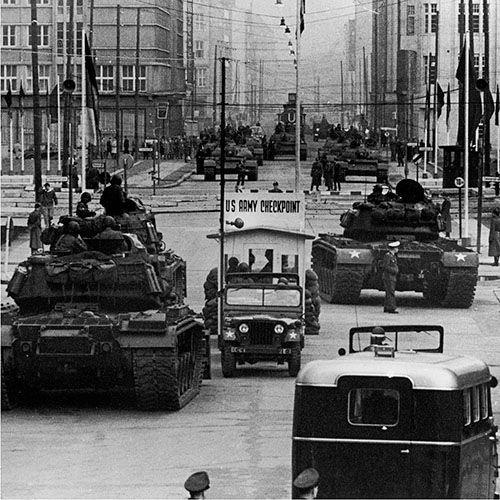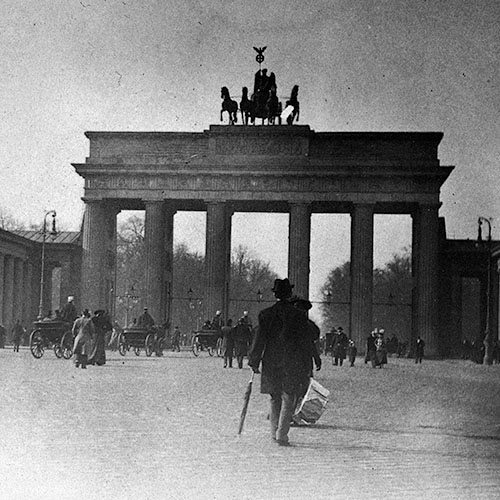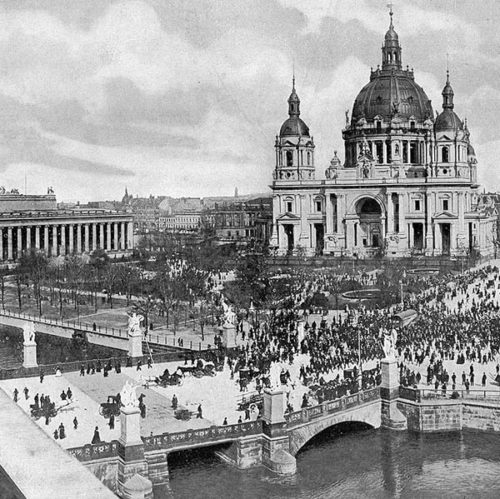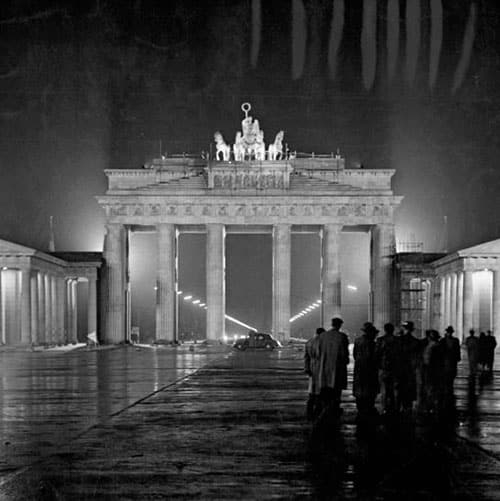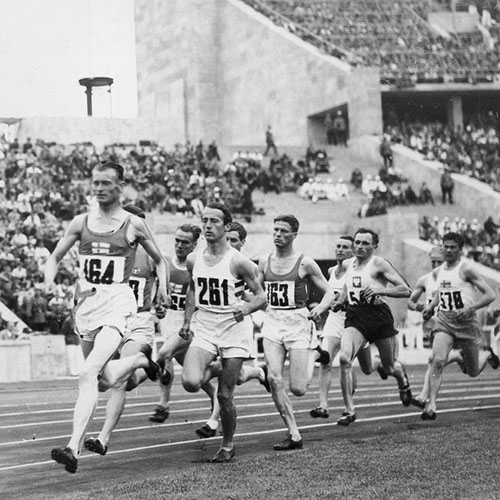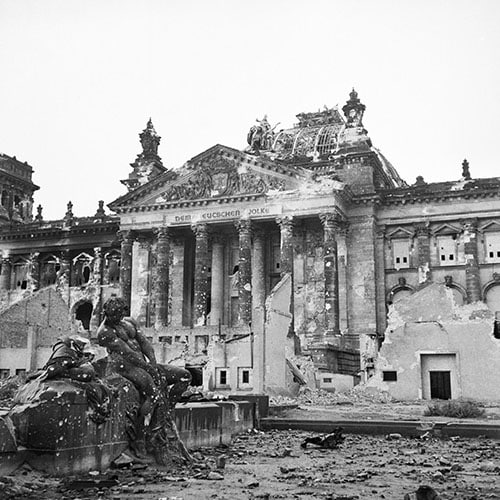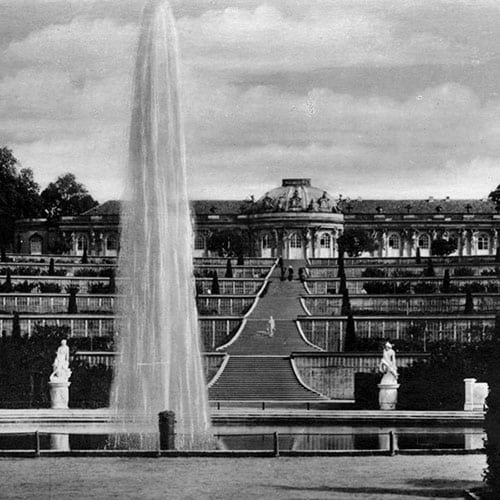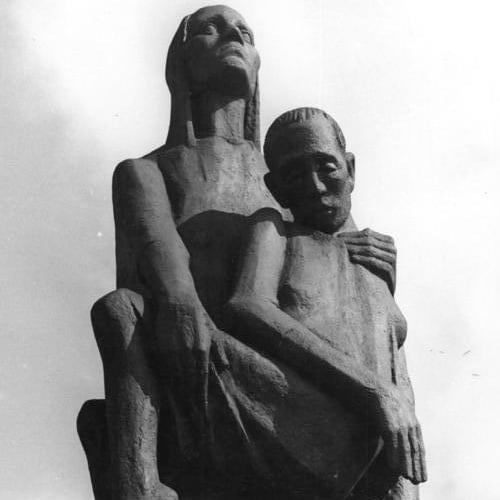“Berlin is the capital of the 20th century because it is the capital of memory. It remembers what other cities try to forget.”
Neil MacGregor, Historian (Germany: Memories of a Nation)
Berlin is a city that wears its scars openly, yet it is also a master of camouflage. The physical erasure of the Third Reich was so thorough that a visitor walking down Unter den Linden today would be hard-pressed to find a single swastika.
This absence creates a vacuum that is often filled by myth.
The most common assumption is that Berlin was once cluttered with statues of Adolf Hitler and that these were all toppled in a Lenin-in-Ukraine style purging after May 1945.
The reality is far more interesting.
The absence of Hitler statues is not just a result of Allied destruction; it was, paradoxically, a result of Nazi design.
And while the man himself is missing from the plinths, his heraldic avatar – the Reichsadler – is still perched on facades across the city, if you know where to look.
–
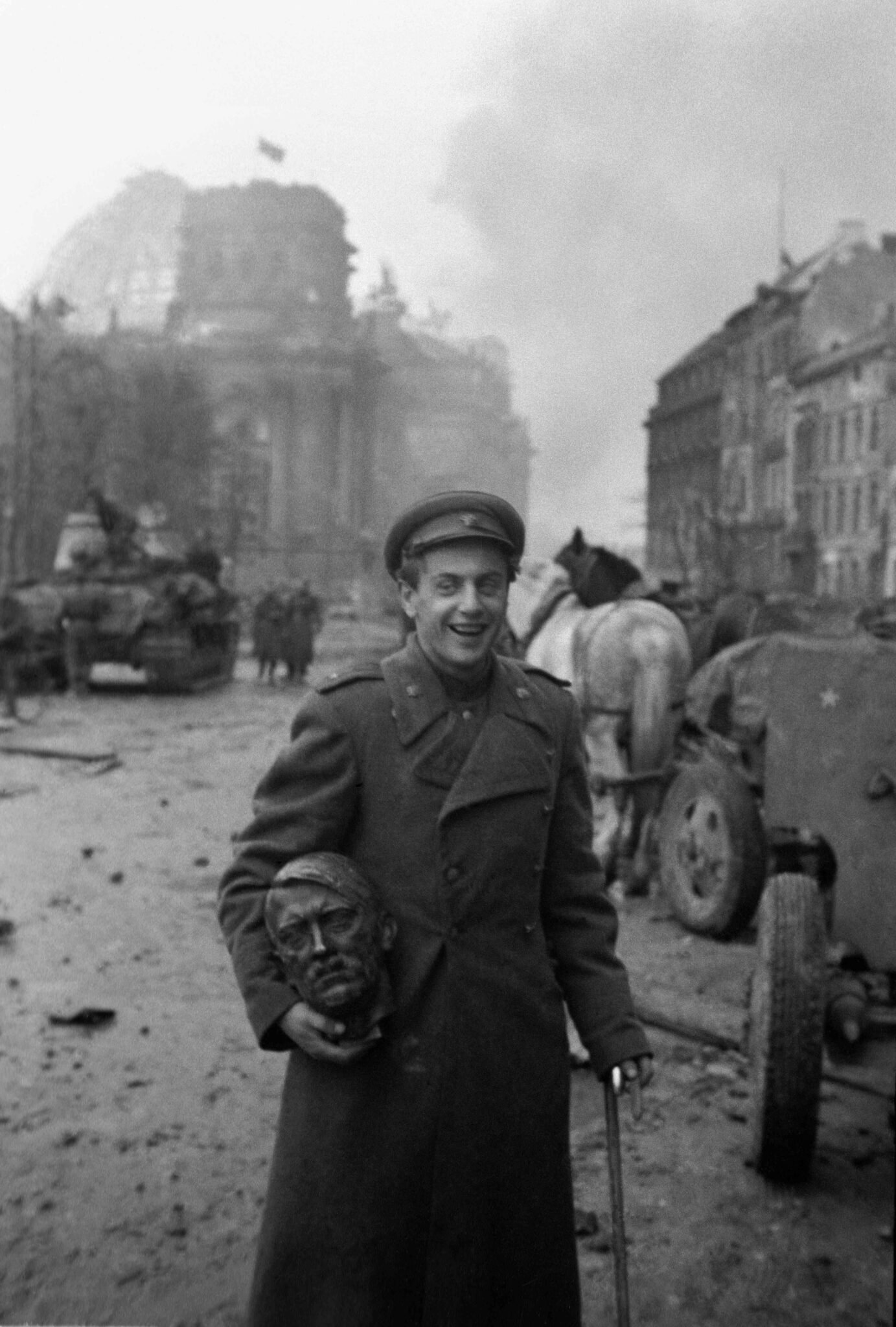
The Prohibition on the Erection of Monuments to the Führer
“The prohibition of statues was a masterstroke of propaganda. By making himself invisible in stone, he made himself ubiquitous in spirit.”
Ian Kershaw, Historian
In the early days of the Third Reich, sycophancy was rampant.
Local mayors and party officials, eager to curry favor with the new Chancellor, began commissioning busts and planning town square monuments in his honor.
Hitler, however, was a man obsessed with control—specifically, control over his own image.
He viewed these provincial, often artistic failures as an embarrassment.
Consequently, in December 1933, the Reich Minister of the Interior issued a decree that baffled many of the party faithful: “The Führer has again decreed that no Hitler monuments, memorial plaques, or the like may be erected or placed during his lifetime. Insofar as this has already been done, the monuments and plaques are to be removed immediately.”
Why would a narcissist ban monuments to himself?
Hitler’s vanity was not the vanity of a traditional monarch; it was the vanity of a messiah.
He believed that Germany itself was his monument.
He didn’t want to be a statue gathering pigeon droppings in a market square; he wanted to be the architect of the entire state.
Furthermore, he was acutely aware of the transient nature of bad art.
He feared that mediocre sculptors would create caricatures that would undermine his ‘divine’ aura.
The only exceptions were busts for indoor display in official buildings, which were strictly regulated by the Reichskammer der Bildenden Künste (Reich Chamber of Fine Arts).
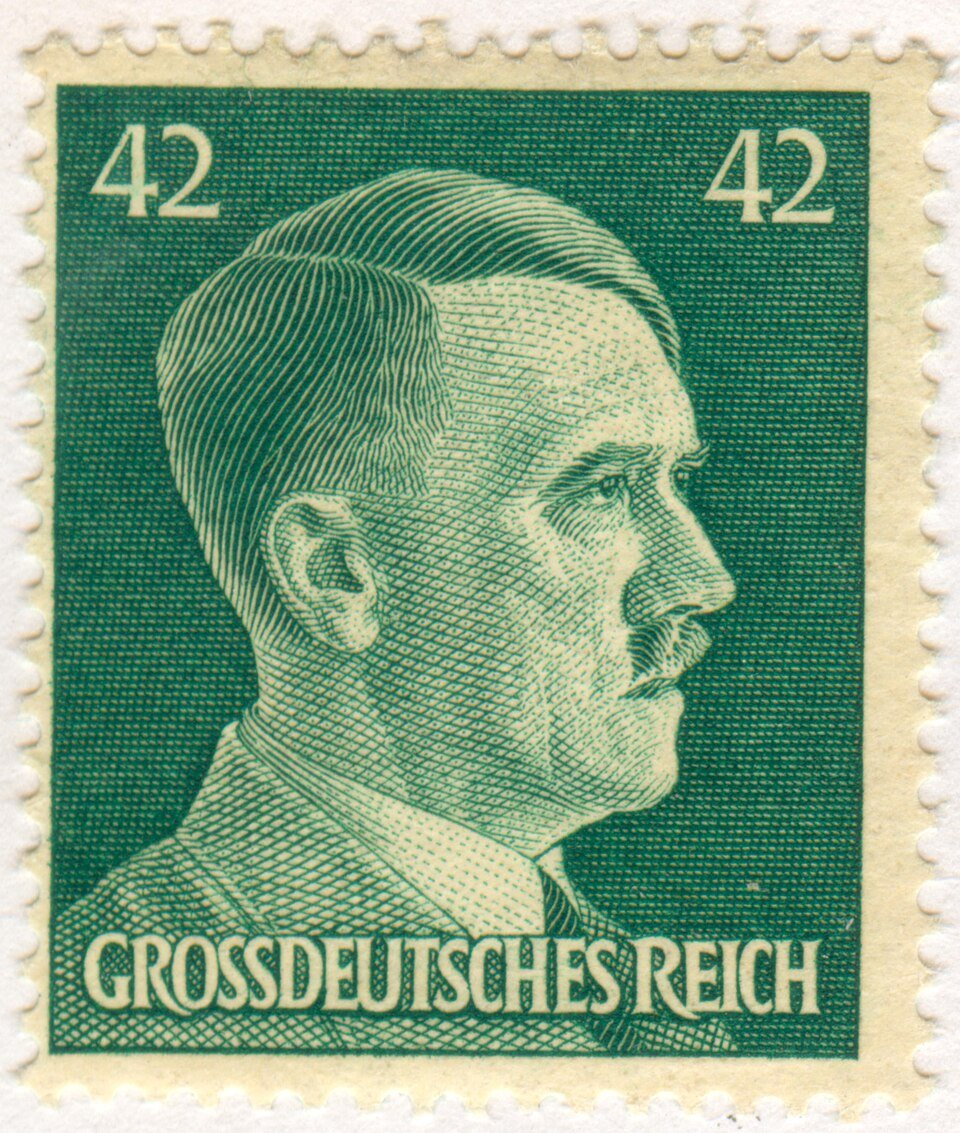
The Money vs. The Stamp
This desire for image control extended to the currency. During the hyperinflation of 1923, money had become worthless trash, swept into gutters. Hitler, scarred by this memory, refused to have his face printed on banknotes or minted on coins, fearing the symbolism of his image being devalued or handled by dirty fingers.
However, his modesty vanished when it came to postage stamps.
Why?
Royalties.
A savvy businessman, Hitler negotiated a deal where he received a percentage of the sale of every stamp featuring his image. Since these stamps were mandatory for daily life, this generated millions of Reichsmarks in personal income—a ‘portrait right’ fee that the Reichsbank (the central bank) refused to pay for coins, but the Reichspost paid willingly.
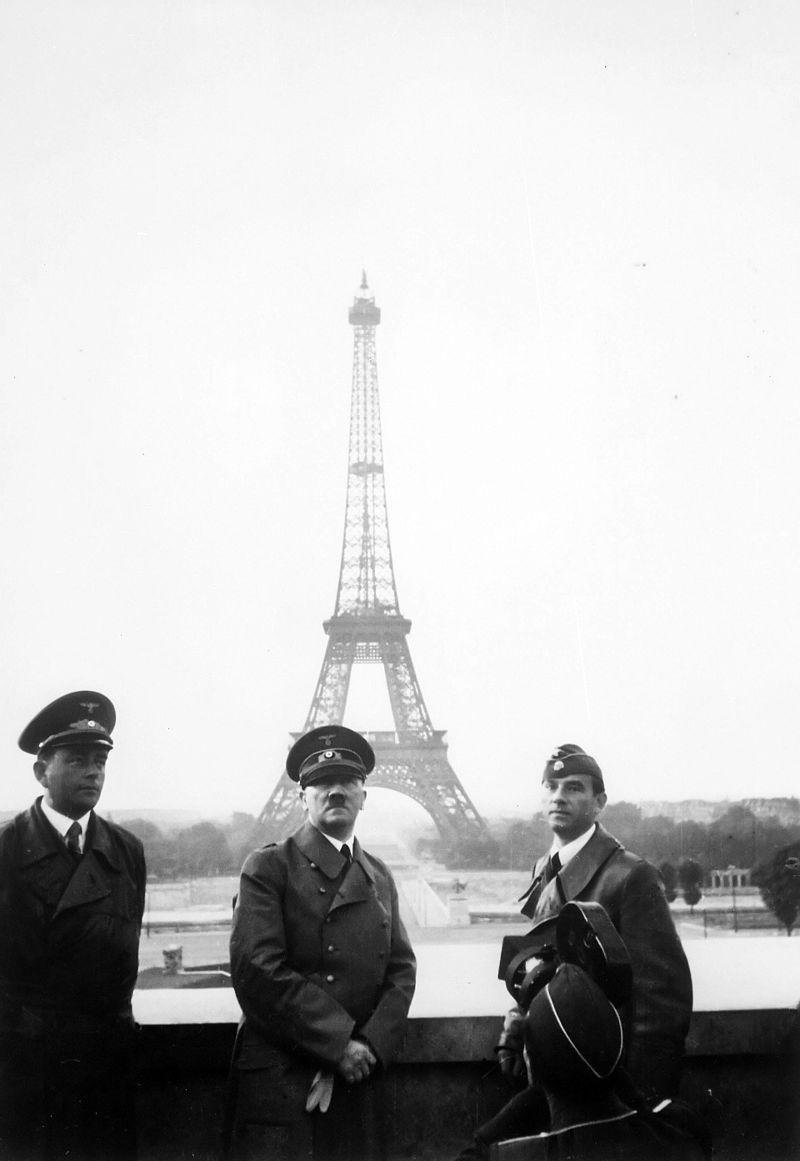
The Nazi Aesthetic: Reliving Greece and Rome
Since they couldn’t build statues of the Leader, the Nazis pivoted to statues of the Ideal.
The Third Reich’s artistic vision was a rejection of ‘degenerate’ modernism (Expressionism, Dadaism) in favor of a hyper-masculine, monumental Neoclassicism.
They saw themselves as the spiritual successors to the Roman Empire and ancient Greece.
Nazi sculptors like Arno Breker and Josef Thorak were commissioned to create ‘The New Man’—perfectly proportioned, muscular, emotionless figures that projected strength and obedience.
These statues were not meant to be human; they were meant to be racial archetypes.
They adorned the Olympic Stadium and the Chancellery, serving as silent guardians of the ideology.
While the man was missing, the Übermensch was everywhere.
–

The Nazi Eagle
“The eagle is the oldest symbol of German unity, but in the hands of the Nazis, it became a bird of prey.”
Richard J. Evans, Historian
While Hitler’s face is absent, the Eagle (Adler) remains – if you know where to find it.
To understand what you are seeing in Berlin today, you must understand the heraldry.
The eagle has been a German symbol since Charlemagne and the Holy Roman Empire (the First Reich).
However, the Nazis codified a specific visual language for it.

The Reichsadler (Imperial/State Eagle): The eagle looks over its right shoulder (the viewer’s left). This symbolized the State and the Government.

The Parteiadler (Party Eagle): The eagle looks over its left shoulder (the viewer’s right). This symbolized the NSDAP (Nazi Party).
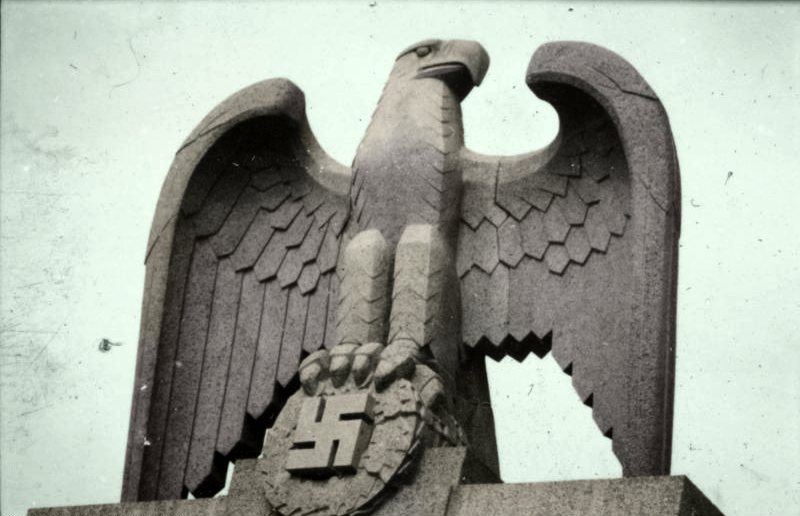
This distinction was crucial.
A ‘Party Eagle’ on a building marked it as a political headquarters, while a ‘State Eagle’ marked a government ministry.
The Nazi design was distinct from the Weimar or Imperial eagles: it was stylised, angular, Art Deco-influenced, and aggressive, typically perched on a wreath of oak leaves containing a swastika.

Remaining Eagles in Berlin
Today, walking through Berlin is a scavenger hunt for these predatory birds. After the war, the Allies issued Order No. 30, requiring the removal of all Nazi memorials. However, chipping a massive stone eagle off a structural façade was expensive and difficult.
The solution?
Denazification by chisel.
The swastika was ground off, but the eagle was left behind.
Here are the most prominent “Ghost Eagles” you can still find:

Finanzamt Charlottenburg (Bismarckstraße 48): This is perhaps the most chilling example. Above the entrance to this massive tax office sits a terrifyingly stern Reichsadler. The wreath in its talons is still there, but the swastika has been plastered over. In a stroke of grim irony, the house number ‘48’ now sits exactly where the crooked cross used to be.
Tempelhof Airport (Platz der Luftbrücke): The massive eagle head monument in the forecourt (discussed below) is the most famous, but look closely at the corners of the airport buildings. There are relief eagles carved into the limestone, their talons now clutching empty wreaths.
Former Reich Ministry of Transport (Voßstraße): In the shadow of the Mall of Berlin, parts of the old government district survive. You can occasionally spot the outline where an eagle once was, a ‘scar’ on the building’s skin.
The Olympic Stadium’s Langemarckhalle: A plaque with a Nazi-era eagle still stands (swastika removed) at the First World War memorial hall.
The Ernst-Moritz-Arndt Church: Built in 1935 in Berlin-Zehlendorf, there is still a Nazi eagle visible here, minus any Nazi emblem.
The Invalidenhof Cemetery: The tomb of General Hans von Seeckt (a First World War hero) has a pair of 1936 eagles on it, since he died that year when Nazis were honoring old Prussian officers.
The Siemensstadt Eagle: Astonishingly, a Nazi-era sculpture stands in a children’s playground in Berlin-Siemensstadt, and remained largely unnoticed for decades. The statue of an eagle family by one of the Nazis’ favorite sculptors, it was put here as a monument to the so-called National Uprising in 1933 when the Nazis seized power. In 1935, the local Nazi administration installed this statue (a parent eagle with eaglets, symbolising the rebirth of the nation). After the war, it wasn’t removed and ended up within a housing estate playground. Only recently have locals debated what to do about this odd relic.
–
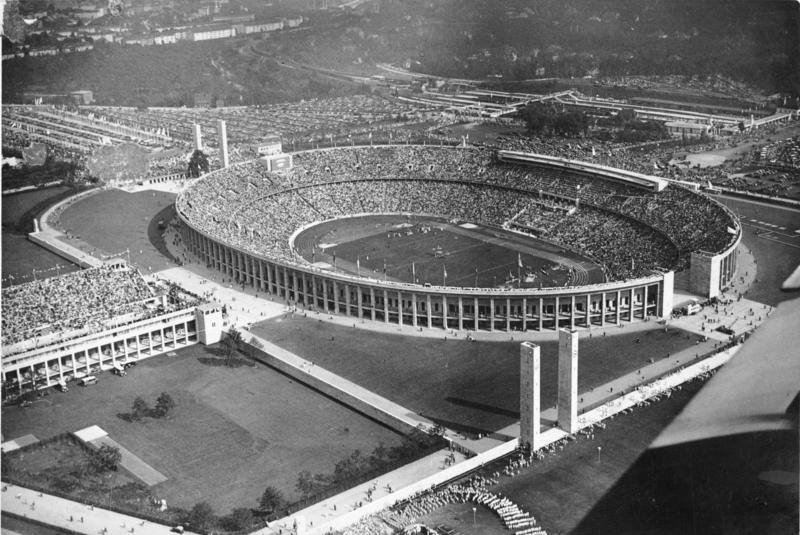
The 1936 Summer Olympics - The Nazi Games
“The Olympic Bell called the youth of the world, but it rang with a hollow tone. It was cast in steel, not bronze, fitting for a nation preparing for war.”
Werner March, Architect of the Olympic Stadium
The 1936 Olympics were the debutante ball for the Nazi aesthetic.
The Olympiastadion (Olympic Stadium) was designed by Werner March, but it was the sculptural elements that drove home the ideology. Today, walking around the stadium feels like stepping into a Leni Riefenstahl film.
You are surrounded by giants.

The Horse Tamers and The Discus Throwers
The stadium is still ringed by the statues of the era.
The most prominent survivors are the ‘Horse Tamers’ (Rossebändiger) by Joseph Wackerle, guarding the Marathon Gate. These aren’t just equestrian statues; they are political metaphors. Unlike traditional equestrian statues where the rider sits easily, here, nude muscular men strain to control wild, powerful beasts. It represents the Nazi concept of Bändigung—the forceful taming of chaotic nature (or the populace) by the iron will of the Leader.

Inside the grounds, specifically near the House of German Sports (Haus des Deutschen Sports), you will find the ‘Discus Throwers’ and ‘Relay Runners’ by Karl Albiker and monuments by Arno Breker. Breker, the ‘Michelangelo of the Third Reich’, specialized in hyper-masculine figures with distinct Aryan facial features—chiseled jaws, expressionless gazes, and exaggerated musculature that anatomic experts have noted are biologically impossible (muscles exist on these statues where humans have none).
These Nazi statues were spared destruction because they were deemed ‘classical’ rather than overtly political—a testament to how successfully the Nazis camouflaged their ideology as ‘art’ – dressing their ideology in the toga of antiquity.
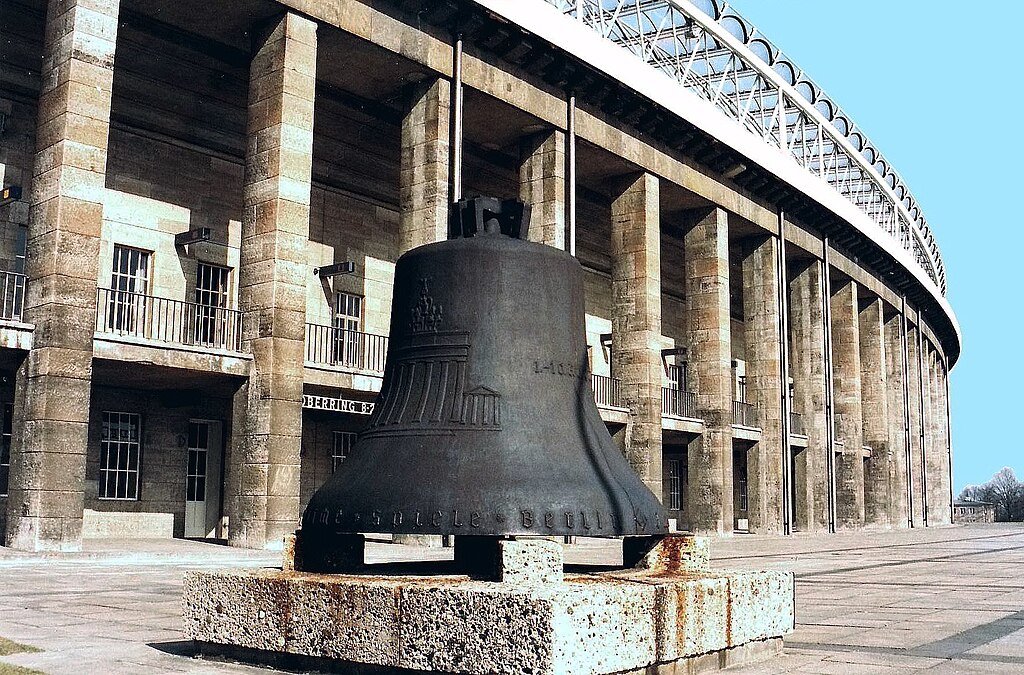
The Olympic Bell
The most haunting relic is the Olympic Bell.
Originally, it hung 77m high in the Glockenturm (Bell Tower). Cast by the Bochumer Verein foundry, it was a monster of engineering, weighing 9.6 tons. Notably, it was cast in steel, not bronze. In 1936, the German war economy was already quietly hoarding copper and bronze for shell casings and cannons. The ‘Peace Bell’ was literally made of the stuff of tanks.
It now sits on the ground outside the stadium.
If you approach the bell today, you can see the localized vandalism of history. On the side of the bell, the Nazi Eagle clutching the swastika was cast in high relief. After the war, someone took an angle grinder or a chisel to it.
The swastika is gone, replaced by a rough, rusted square of abraded metal. Yet, the outline of the eagle remains visible, ghost-like. It is a “negative monument”—the removal of the symbol draws your eye to it more effectively than the symbol itself ever did.
This broken, silenced instrument, which once summoned the world to a deceptive festival of peace, now sits silently in the bushes—a perfect, cracked metaphor for the regime that cast it.
–

Tempelhof Airport & the Ministry of Aviation
“Tempelhof is a strange beast. It is beautiful in its utility, but terrifying in its scale. It was built to impress, not to welcome.”
Colin Philpott, Historian (Relics of the Reich)
Hermann Göring’s Luftwaffe required headquarters that matched their ego.
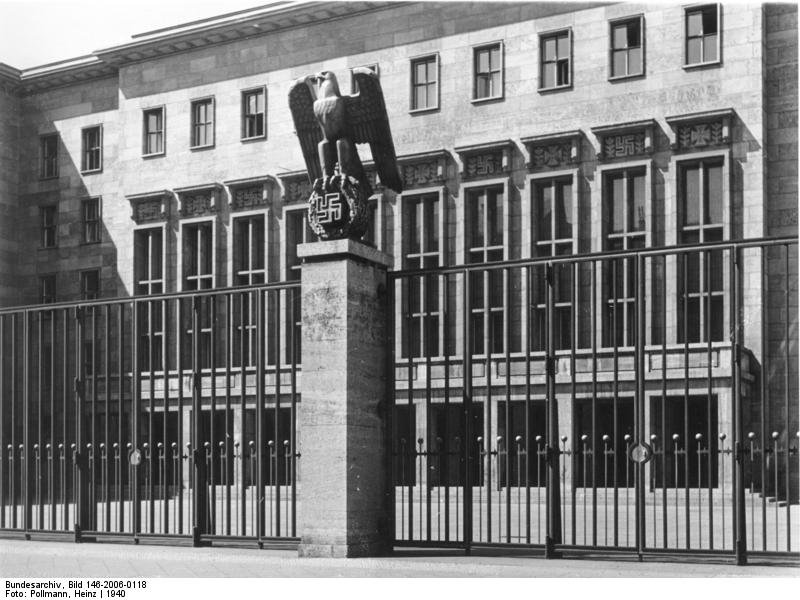
The Ministry of Aviation (Detlev-Rohwedder-Haus)
Located on Wilhelmstraße, this was the largest office building in the world when it opened in 1936.
It is one of the few major Nazi buildings to survive the war largely intact. Today, it houses the German Finance Ministry.
The building has been “cleansed”—the eagles and swastikas were removed, and a socialist mural by Max Lingner was added during the GDR era. However, the sheer oppressive scale of the architecture remains a “statue” to the regime in itself.

Tempelhof Airport
Sir Norman Foster once described Tempelhof as the “mother of all airports.”
Built between 1936 and 1941, its curved limestone facade stretches for over a kilometer.
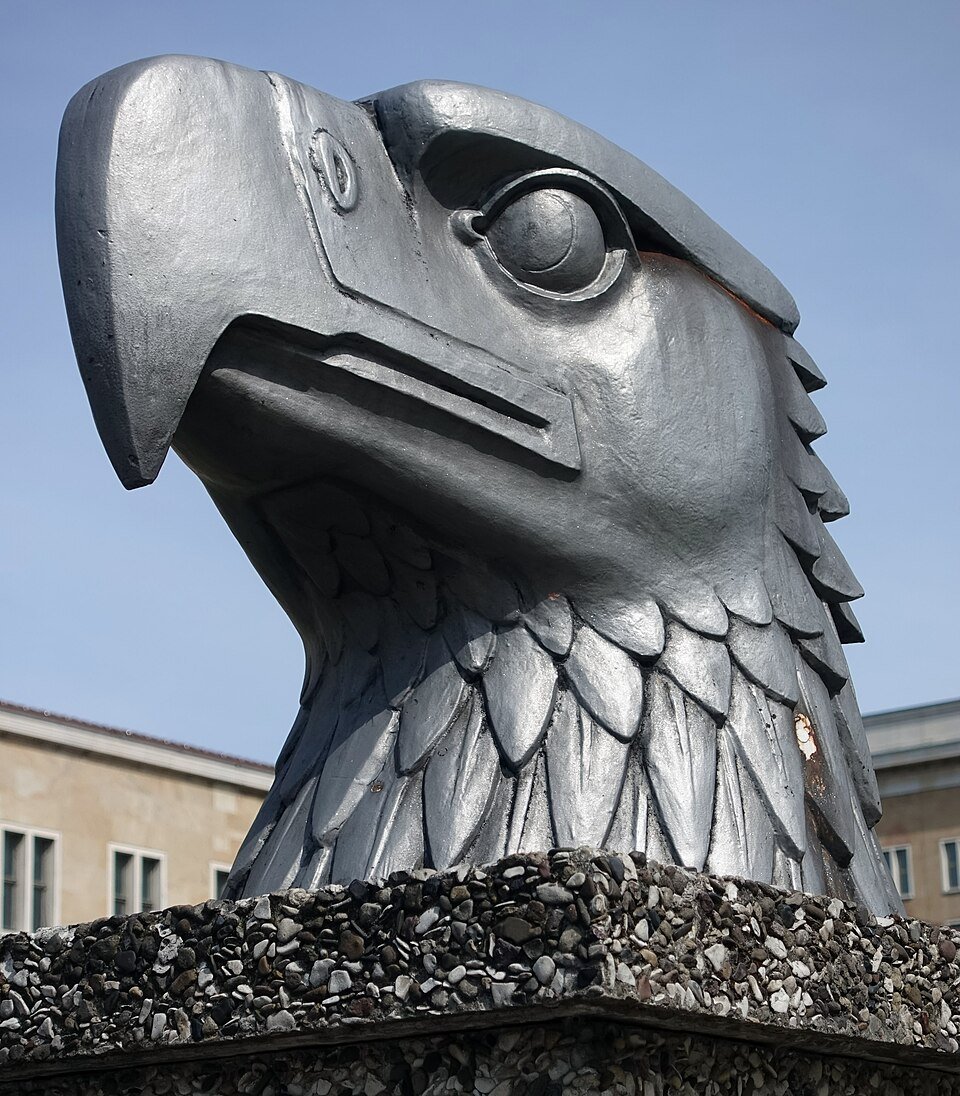
The Eagle Myth: There is a persistent myth that the airport was designed to look like an eagle from the air. In reality, the design is a quadrant of a circle (intended to be a full circle eventually). However, the ‘spread wings’ of the hangars give it an avian appearance that fits the legend perfectly.
The Roof Eagle: A massive aluminium eagle once stood on the roof of the main terminal. After the war, it was taken down and the head was sent to the US Military Academy at West Point as a trophy. It was returned to Berlin in 1985 and now sits on a plinth in front of the airport. It is disembodied, staring blindly across the intersection—a literal head of state without a body.
–

Hitler’s Horses & The Nazi Statue Graveyard
“At Spandau, we do not hide the monsters. We put them in a room so we can look them in the eye and see that they are just stone.”
Urte Evert, Curator at Spandau Citadel
For decades, it was assumed that the bronze statues that guarded the Neue Reichskanzlei (New Chancellery)—Hitler’s seat of power—were destroyed by Soviet artillery.
The Chancellery itself was demolished, its red marble rumored to have been used in the Soviet War Memorial at Treptower Park (another myth, mostly false; the marble came from elsewhere).
But what about the ‘Striding Horses’ by Josef Thorak?
These massive stallions stood in the Chancellery garden, visible in Hitler’s view from his office.
In 2015, a Dutch art detective named Arthur Brand received a tip. The horses weren’t melted down. They were being offered for sale on the black market for €8 million. In a sting operation worthy of a Hollywood thriller, German police raided a warehouse in Bad Dürkheim. There, amidst tires and junk, stood the Führer’s horses, along with statues by Arno Breker.
They had been smuggled out of Berlin during the war, stored in a Soviet barracks for decades (painted gold to hide them!), and then privately acquired.
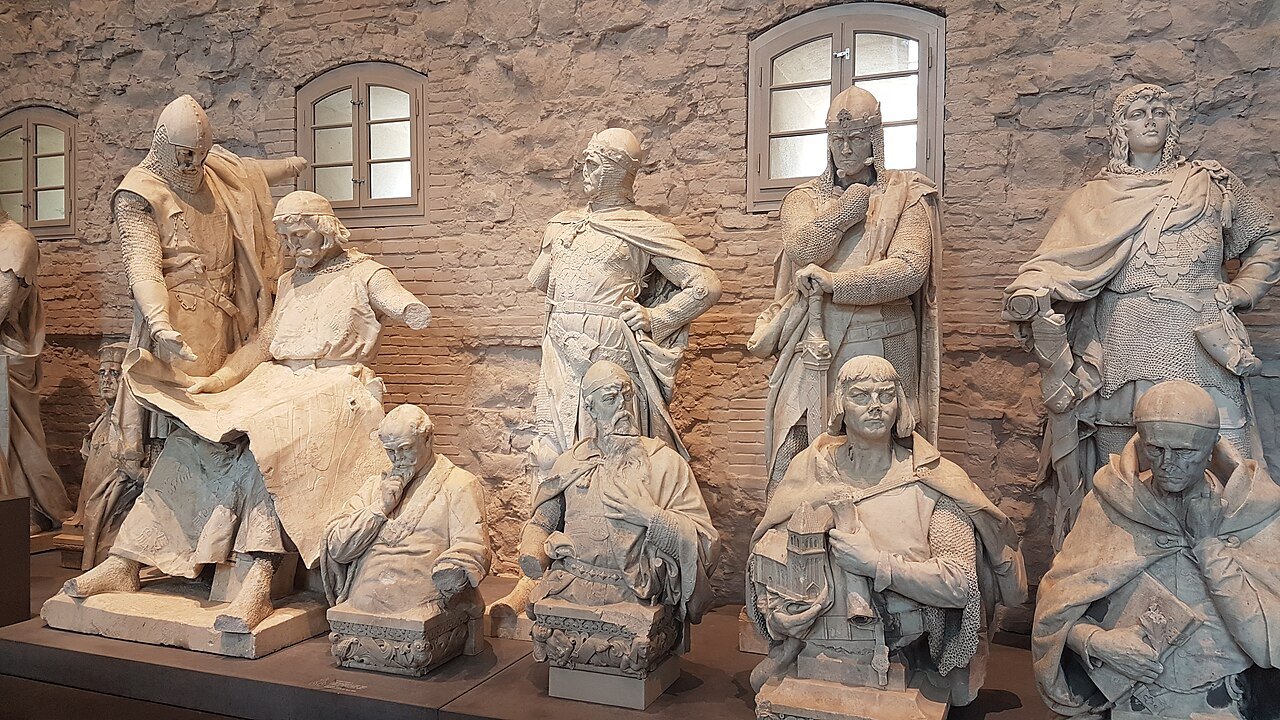
Spandau Citadel: The Island of Unwanted Monuments
Today, these horses are not hidden.
They are on display at the Spandau Citadel in the museum exhibit Unveiled: Berlin and its Monuments. Here, Berlin has finally found a way to deal with its toxic statues.
They are not put on pedestals to be worshipped, nor are they hidden in basements. They are displayed at eye level, stripped of their power, contextualized as historical artifacts rather than idols.
You can walk right up to Hitler’s horses and touch the bronze.
They feel cold, heavy, and surprisingly ordinary.
–
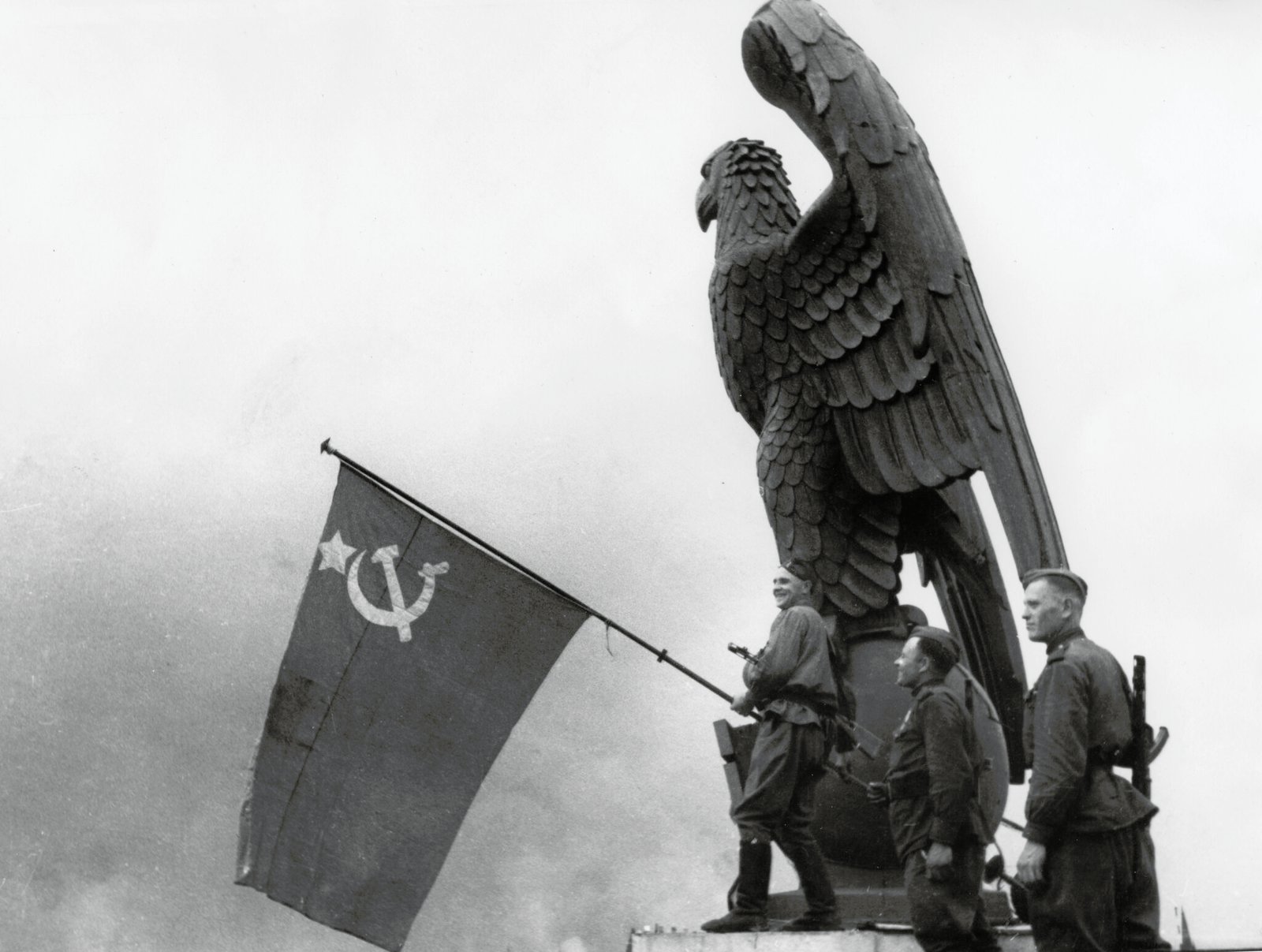
Conclusion
“The body was the ultimate monument in the Third Reich. Stone was just a way to freeze the flesh.”
George L. Mosse, Historian
So, are there any Nazi statues left in Berlin?
If you are looking for a bronze Hitler in a public square, the answer is no—he ensured that himself in 1933, and the Allies finished the job in 1945.
But if you define ‘statues’ as the stone symbols of the regime—the eagles, the bells, the muscular guardians of the stadium, and the architecture itself—then Berlin is still teeming with them.
They remain not as shrines, but as scars.
The denazified eagles on the tax offices and the cracked bell at the stadium serve as a reminder that history cannot be simply deleted.
It must be confronted.
Berlin has chosen not to erase these ghosts entirely, but to force them to live among the living, silent and powerless, reminding us of the fragility of civilisation.
***
If you’ve enjoyed reading this article, consider booking one of our private guided tours of Berlin.
Bibliography
Beevor, Antony (2002), Berlin: The Downfall 1945, Viking Press / Penguin Books, ISBN 978‑0‑14‑103239‑9.
Brand, Arthur (2020), Hitler’s Horses: The Incredible True Story of the Detective Who Infiltrated the Nazi Underworld
Craig, Gordon Alexander (1982), The Germans
Clark, Toby (1997), Art and Propaganda in the Twentieth Century
Evans, Richard J. (2005), The Third Reich in Power
Gerlach, Stefan M. (ed.) (2020), Unveiling Berlin: The City’s Monuments and Memorials
Helmer, Stephen D. (1985), Hitler’s Berlin: The Speer Plans for Reshaping the Central City, UMI Research Press, ISBN 0‑8357‑1682‑1 / 978‑0‑8357‑1682‑6
Kershaw, Ian (1987), The “Hitler Myth”: Image and Reality in the Third Reich
Large, David Clay (2007), Nazi Games: The Olympics of 1936
Ladd, Brian (1997), The Ghosts of Berlin: Confronting German History in the Urban Landscape
Lowe, Keith (2017), The Fear and the Freedom
MacGregor, Neil (2014), Germany: Memories of a Nation
Moorhouse, Roger (2010), Germania: Hitler’s Capital
Petropoulos, Jonathan (2000), The Faustian Bargain: The Art World in Nazi Germany
Philpott, Colin (2016), Relics of the Reich: The Buildings the Nazis Left Behind
Spotlight: Stratigakos, Despina (2024), The Spotless Face: Adolf Hitler in the Public Eye
Speer, Albert (1970), Inside the Third Reich
Spotts, Frederic (2002), Hitler and the Power of Aesthetics
(Exhibition Catalogue) (2016), Unveiled: Berlin and its Monuments (Exhibition Catalogue, Zitadelle Spandau)
HISTORICAL ARTICLES
Mythbusting Berlin

Are There Any Nazi Statues Left In Berlin? – Mythbusting Berlin
Visitors to Berlin often arrive expecting to find the physical remnants of the tyranny of the 20th century still standing – statues of dictators, triumphal arches, or bronze idols. Instead, they often find none. The stone symbols and statues of the Third Reich are still gazing down on them, however, hiding in plain sight. But why are there no statues of Hitler? Did the Allies destroy them all in 1945, or is the truth stranger
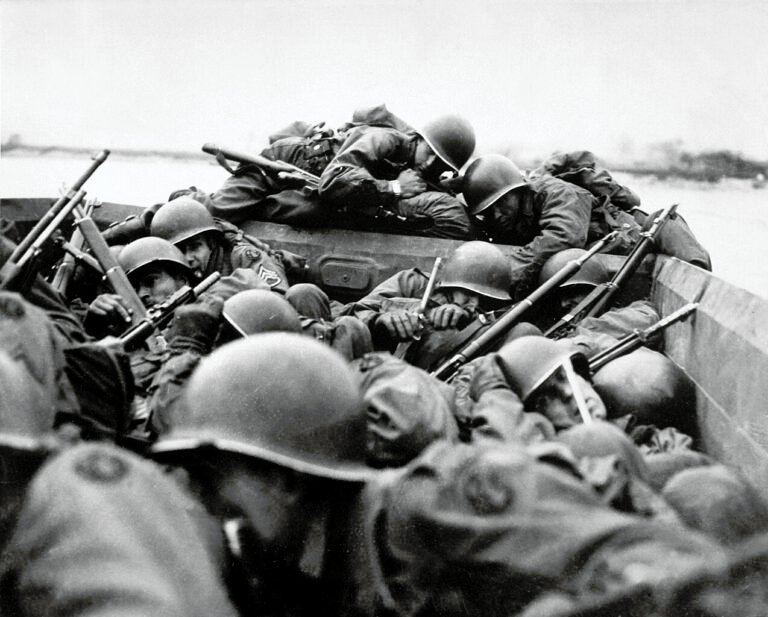
Could The Western Allies Have Captured Berlin? – Mythbusting Berlin
To contemplate a Western Allied capture of Berlin in 1945 is to challenge the established endgame of the Second World War. What was the true military and logistical feasibility of a Western Allied assault on the Nazi capital? What factors truly sealed Berlin’s fate, and what might have changed had the Allies pushed eastward?
Answering these questions means delving into the complex interplay of logistics, political maneuvering, and the competing visions for a post-war world
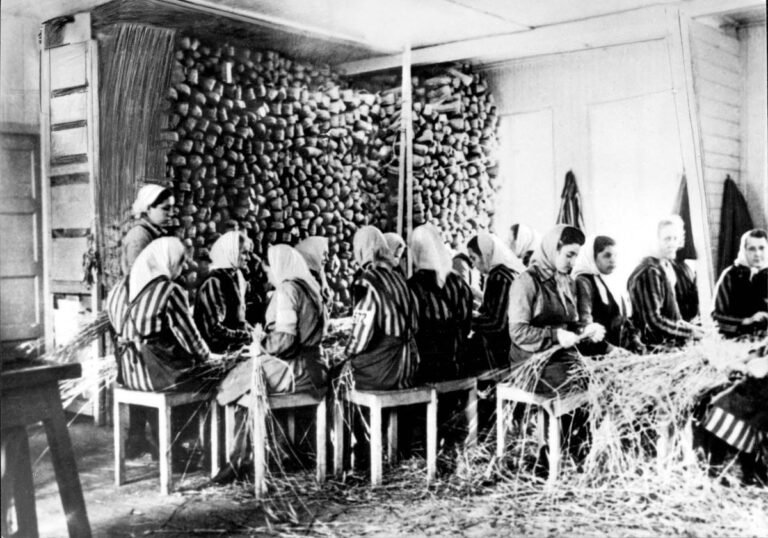
Did Any Of The Rothschild Dynasty Die In The Holocaust? – Mythbusting Berlin
The Rothschild name is synonymous with immense wealth, influence, and persistent conspiracy theories—especially during the era of Nazi Germany. Often targeted by antisemitic propaganda, the family’s survival during World War II has sparked myths about their supposed immunity from Nazi persecution. But did any Rothschild family member actually perish in the Holocaust? This article explores that compelling question, unraveling historical misconceptions and revealing the reality behind one of Europe’s most famous dynasties.
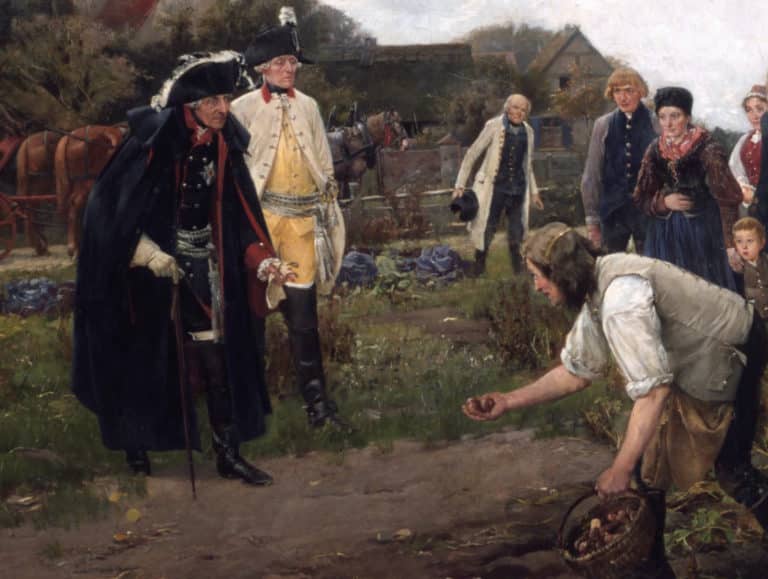
Did Frederick The Great Introduce The Potato To Germany? – Mythbusting Berlin
One of the more bizarre claims to fame attributed to the first King of Prussia is that the man who would go down in history known as Frederick the Great introduced the potato to Germany during his reign back in the 1700s. This starchy root vegetable has undoubtedly become a staple part of German cuisine – an essential addition to any plate of Schnitzel, Schweinshaxn, and Königsberger Klopse – however, whether Frederick the Great is
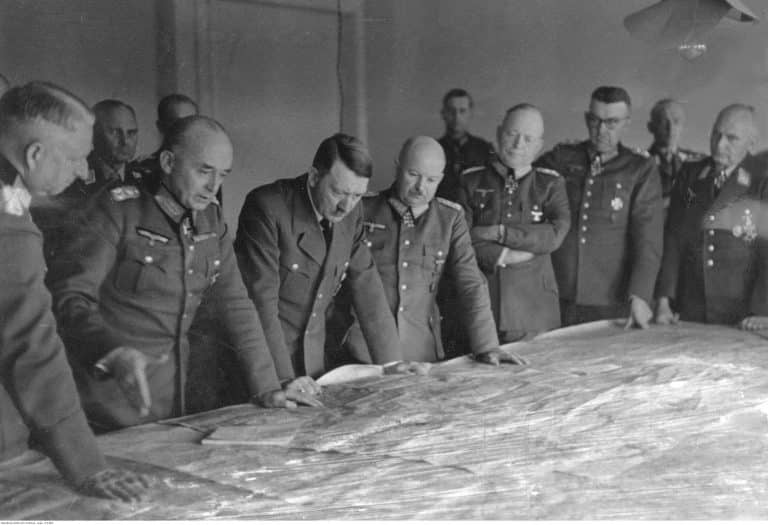
Did Hitler Escape To Argentina In 1945? – Mythbusting Berlin
Although Nazi leader, Adolf Hitler, certainly remains an inescapable figure, could there be any truth to the story of his escape to Argentina in 1945? That the most wanted man on earth could simply vanish, to spend the rest of his life peacefully in South American obscurity captivates imaginations. Yet, despite numerous investigations, this tale persists primarily as myth—fueled by speculation, hearsay, and conspiracy theories.
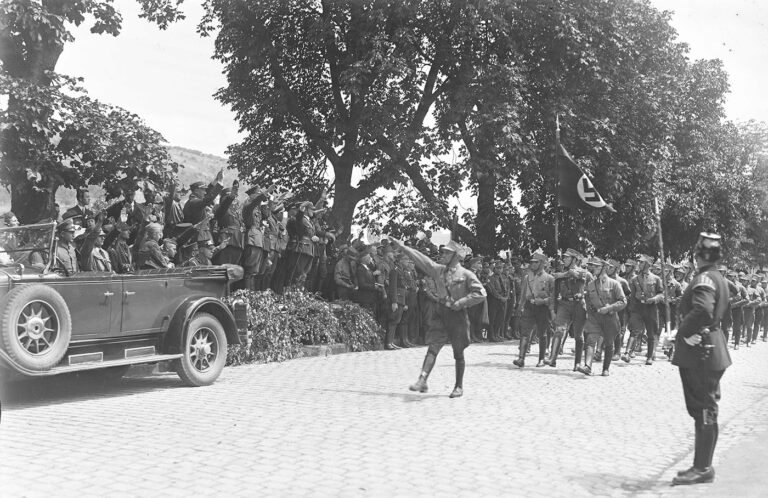
Did Hugo Boss Design The Nazi Uniforms? – Mythbusting Berlin
The idea that Hugo Boss – the man whose name now adorns expensive suits and fragrances – was the creative genius behind the Nazi uniforms suggests a terrifying collision of haute couture and holocaust – a marriage of high style and high crimes. The image is striking: a German tailor sketching the ultimate villain’s costume. But history, as usual, is far messier, more bureaucratic, and more banal than the internet memes suggest. To understand who
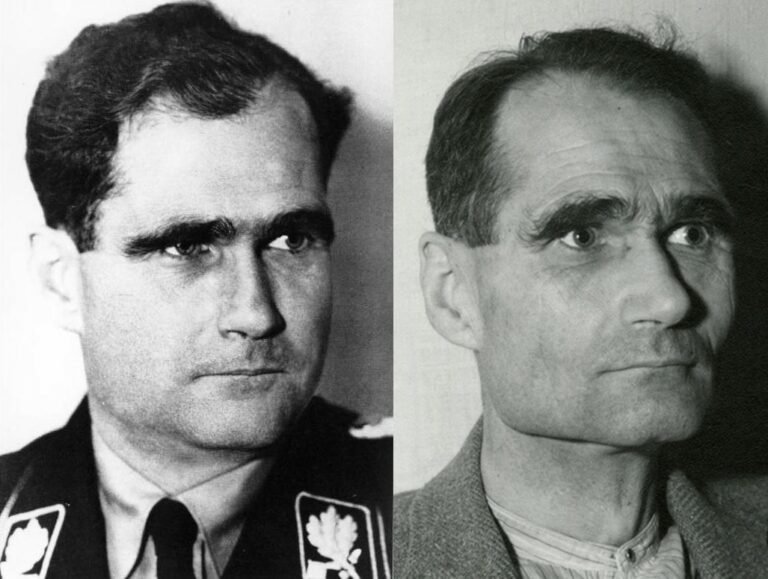
Did Rudolf Hess Really Commit Suicide? – Mythbusting Berlin
On a summer’s day in 1987, the last Nazi war criminal of the Nuremberg trials was found dead in a prison built for hundreds, yet for two decades, housed only him. The official verdict was suicide, a straightforward end to a life defined by fanaticism, delusion, and contradiction.
But the simplicity of the report belied the complexity of the man and the 46 years he had spent in Allied custody. In the meticulously controlled
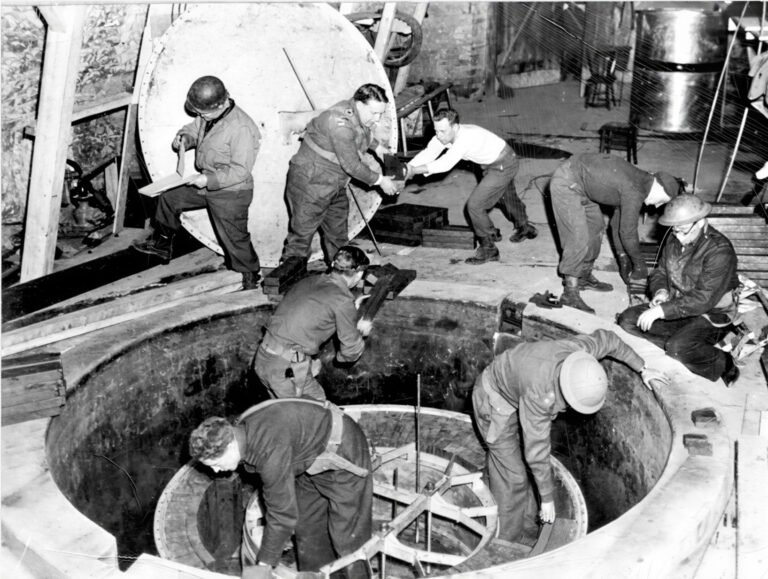
Did The Nazis Develop Nuclear Weapons? – Mythbusting Berlin
The Nazi obsession with super-weapons became so serious in the closing stages of the Second World that Adolf Hitler personally believed that such ‘Wunderwaffen’ both existed in a usable form – and would save the country from defeat. Had the Nazis managed to develop nuclear weapons by 1945 – the outcome of the war would surely have been different. But how close were Hitler, Himmler, and his henchmen to developing an A-bomb?

Did The Nazis Invent Decaf Coffee? – Mythbusting Berlin
Persistent rumors claim that Nazis preferred their coffee anything but pure, leading some to wonder if they might have influenced the development of decaffeinated coffee. Although decaf was already widely available across Europe by the mid-20th century, speculation continues: could the Nazis really have played a role in popularizing—or even discovering—this caffeine-free alternative, or is this simply another caffeinated conspiracy cooked up to sensationalize an ordinary historical detail?

Did The Nazis Invent The Bicycle Reflector? – Mythbusting Berlin
The fruits of wartime ingenuity are plenty – so many, in-fact, that it has become somewhat of a worn cliche that as the guns start firing the innovators get to work, often solving problems while providing more problems for the enemy to overcome.The kind of progress that results in the production of newer improved, more lethal weapons, such as to increase the chances of victory.
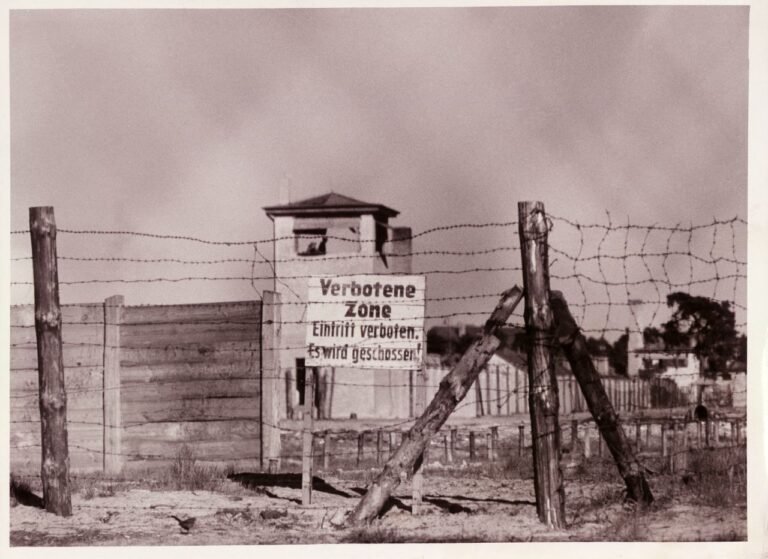
Did The Nazis Run The Largest Counterfeiting Operation In History? – Mythbusting Berlin
During the Second World War the Nazis masterminded an astonishing plot to destabilise Britain by flooding its economy with counterfeit banknotes. Crafted in secret by concentration camp prisoners, this forged fortune became the most ambitious counterfeiting operation ever attempted. But was it history’s largest? Dive into the extraordinary tale of Operation Bernhard,
rife with deception, survival, and intrigue—revealing the truth behind one of the Third Reich’s most audacious schemes and its surprising legacy.
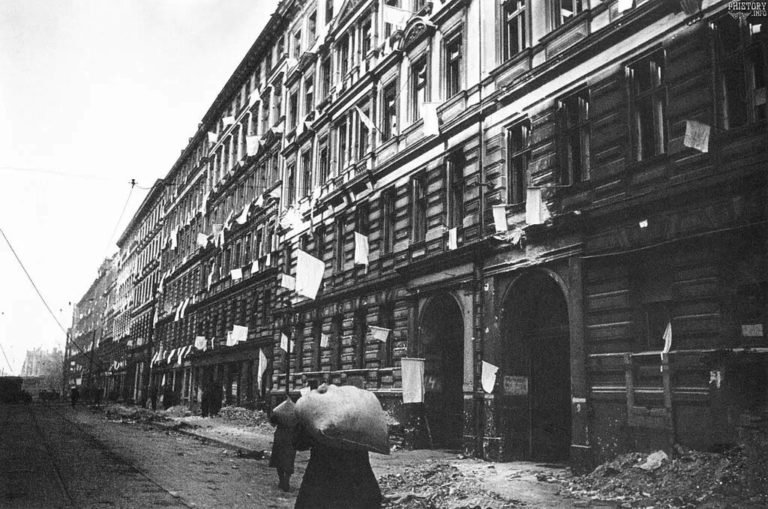
Did The Second World War End In Berlin? – Mythbusting Berlin
When is a war ever truly over? When the last shot is fired in anger would seem like the best measure. Rarely, though, is it possible to gain insight into such a moment.
Remarkably, a record still exists of such a moment at the end of the First World War on the Western Front. A seismic register and recording of the last belching battery of British guns firing artillery across no-man’s-land, followed by a profound
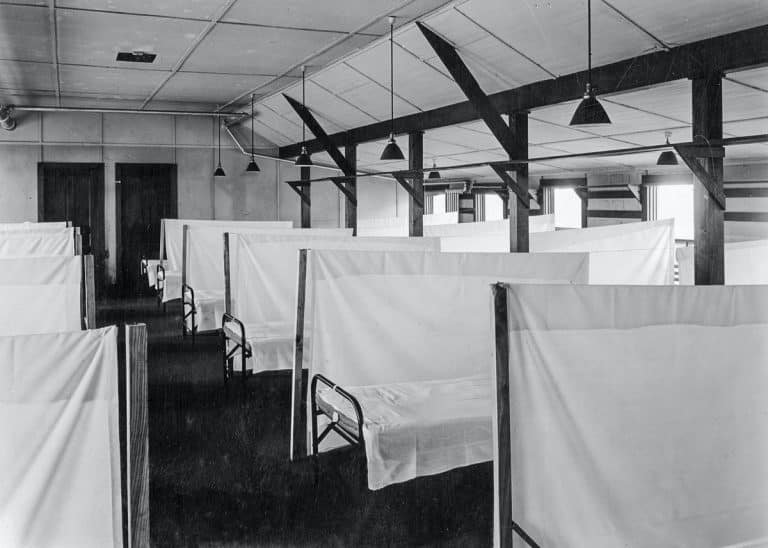
Did The Spanish Flu Pandemic Help The Nazis Take Power? – Mythbusting Berlin
The devastating Spanish Flu pandemic of 1918-1919 struck amid Germany’s post-war turmoil, compounding social instability, economic hardship, and widespread political disillusionment. Could this catastrophic health crisis have indirectly paved the way for Nazi ascension? While often overshadowed by war and revolution, the pandemic’s profound psychological and societal impacts arguably contributed to the perfect storm, enabling extremist ideologies—including Nazism—to gain popularity and ultimately seize power in a fractured Germany.

How Many Assassination Attempts On Adolf Hitler Were There? – Mythbusting Berlin
Nazi leader, Adolf Hitler, projected an aura of invincibility, a man of destiny shielded by providence. But behind the carefully constructed image of the untouchable Führer lies a story of constant threat, of bombs that failed to detonate, and errant bullets that missed their mark. Unearth the hidden history of the numerous attempts on Hitler’s life as we explore the courage of those who tried to change the course of history and the devil’s luck
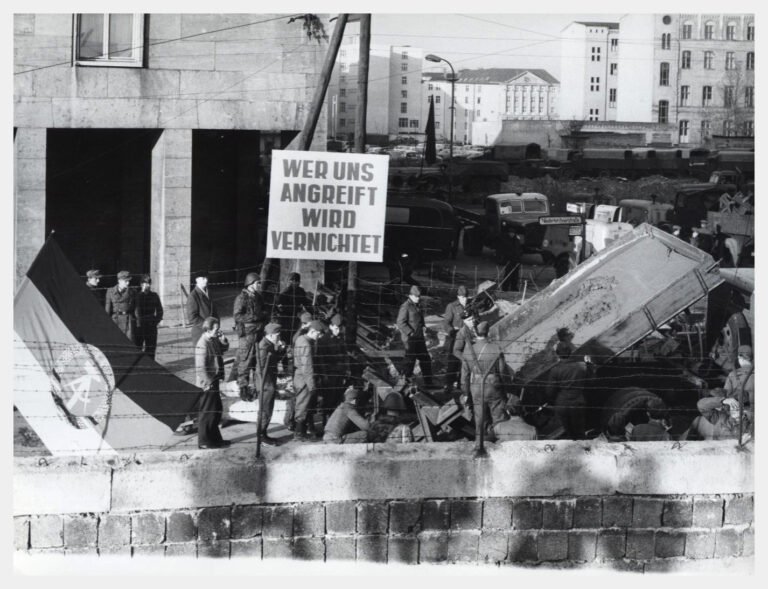
How Many People Died Trying To Escape East Germany? – Mythbusting Berlin
The image of the Berlin Wall is seared into our collective memory, a concrete symbol of Cold War oppression. We think of the daring escapes and the tragic deaths of those who failed. But that well-known number is only a fraction of the truth. The story of those who died trying to escape East Germany is far broader and more complex than most imagine, stretching along a thousand-kilometer border and out into the cold waters
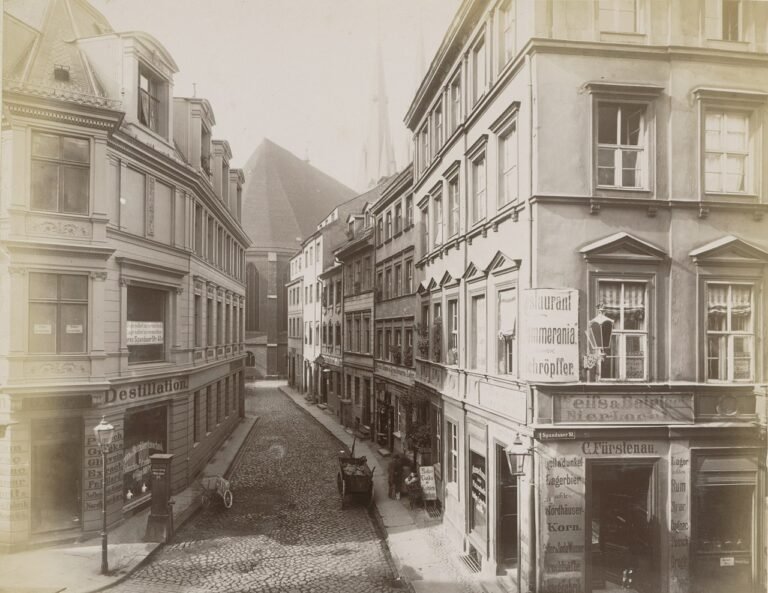
How Old Is Berlin? – Mythbusting Berlin
A relatively new arrival in Europe, Berlin is over 1000 years younger than London, nevermind Rome or Athens, Jerusalem or Jericho. Just how old is Berlin though?
A question fraught with false assumptions and distortions – that has more often than not been answered with propaganda as it has with the cold hard truth.
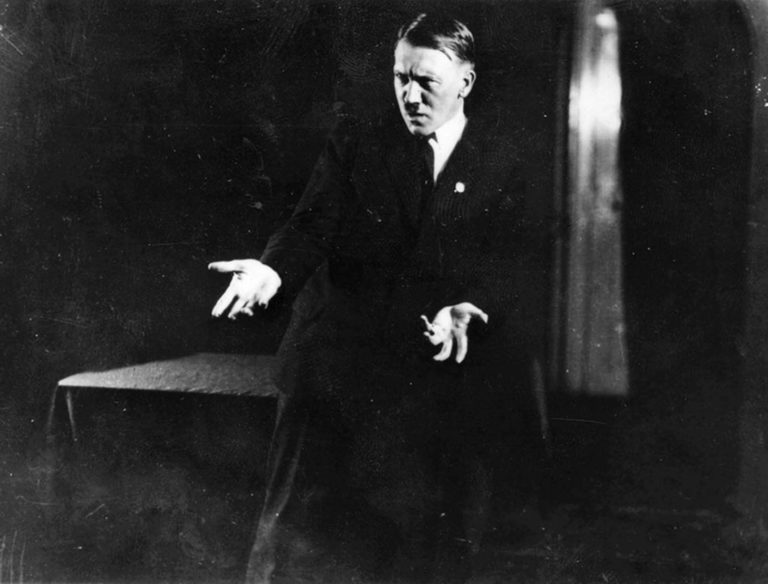
Was Adolf Hitler A Drug Addict? – Mythbusting Berlin
Solving the enigma of the ‘Führer’ has become a preoccupation for many, since the arrival of the Austrian-German onto the world stage – although moving beyond the mythology without falling into the trap of prejudically extrapolating on the psychopathography of Hitler or demonising so as to excuse his actions has proven problematic. What to make of the man who became more than the sum of his masks? The painter; the military dilettante, the mass murderer,

Was Adolf Hitler Gay? – Mythbusting Berlin
In the shadowy corridors of Third Reich history, few questions provoke as much tabloid curiosity and scholarly exasperation as the sexuality of Adolf Hitler. For decades, rumors have swirled—whispered by political enemies in 1930s Munich, psychoanalyzed by American spies in the 1940s, and sensationalized by revisionist authors today. Was the dictator who condemned thousands of men to concentration camps for “deviant” behavior hiding a secret of his own? By peeling back the layers of propaganda,
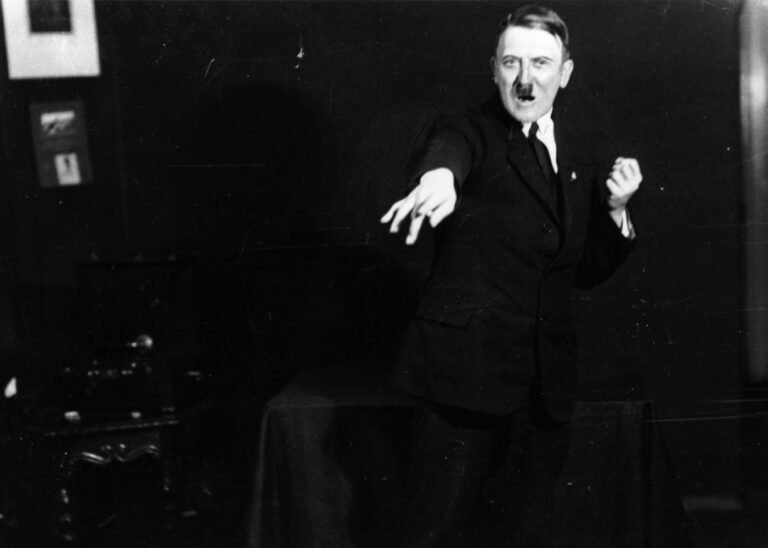
Was Adolf Hitler Jewish? – Mythbusting Berlin
Was the dictator who orchestrated the murder of millions of European Jews secretly one of them? It is perhaps the darkest irony imaginable, a story whispered for decades in backrooms, bars, and conspiracy forums alike. The most-common rumour – the ‘Frankenberger Myth’ – suggests that Adolf Hitler’s paternal grandfather was Jewish, a secret so damaging it could have unraveled the entire Nazi regime. But where does this claim come from? And, more importantly, is there
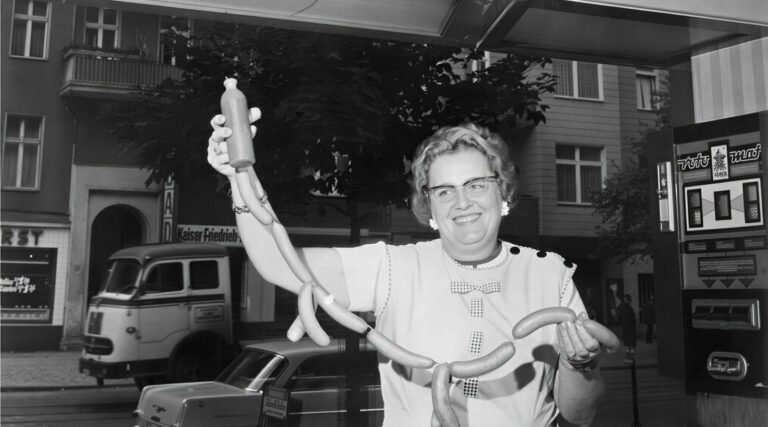
Was Currywurst Invented In Berlin? – Mythbusting Berlin
Explore the story behind what many consider Berlin’s most iconic snack—the ever-so-humble Currywurst. Often hailed as an enduring symbol of culinary creativity amid Cold War scarcity, this humble dish has inspired fierce debate about its true origin. But was it genuinely invented here in Berlin, or have proud locals simply adopted and elevated this spicy street-food favorite into legendary status all their own?

Was Fanta Invented By The Nazis? – Mythbusting Berlin
As one of the most secretive organisations in the world, the Coca Cola corporation refuses to share its secret recipe with anyone. Famously insisting only on shipping the base syrup of its drinks to plants around the world to be carbonated and distributed.
This combined with the trade limitations of the Second World War may have led to the introduction of one of the most popular soft-drinks in the world. But could it be true:
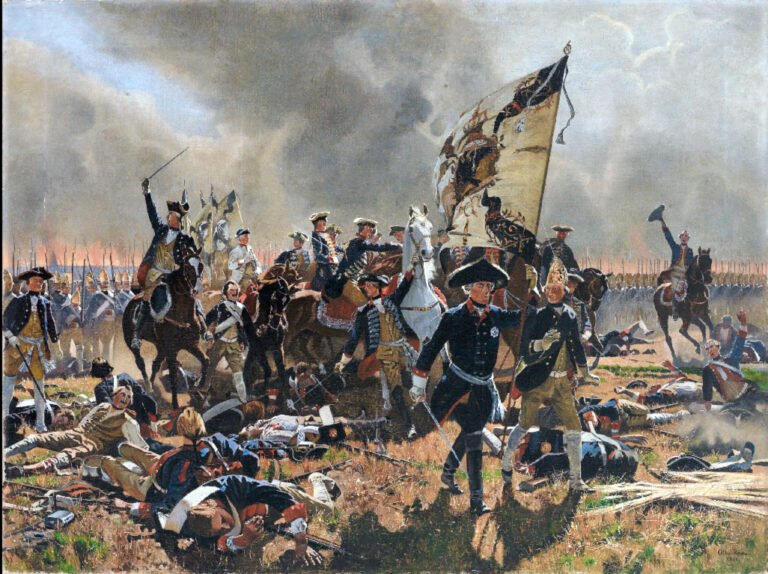
Was Frederick The Great Gay? – Mythbusting Berlin
Frederick II of Prussia, better known as Frederick the Great, is often remembered as the archetypal enlightened monarch – a brilliant military commander, patron of the arts, and learned philosopher. Yet behind the stern portraits of this 18th-century warrior-king lies a personal life long shrouded in intrigue and speculation. Intrigue around the king’s sexual orientation has persisted through the centuries, chiefly revolving around one question: Was Frederick the Great gay?
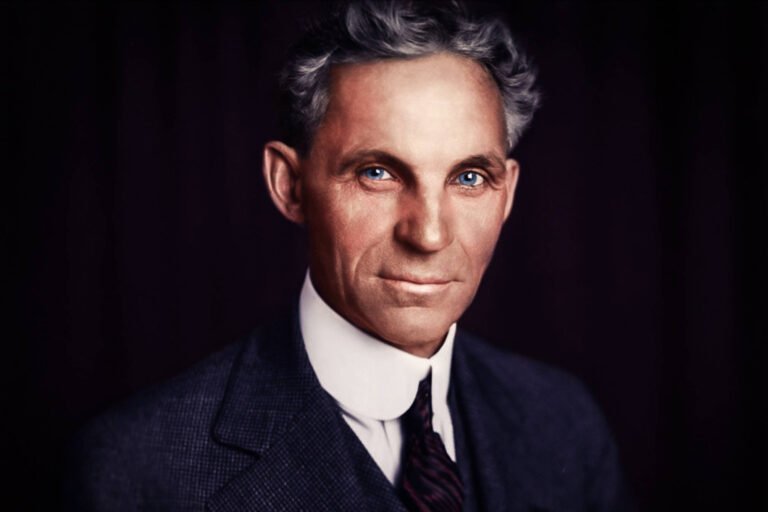
Was Henry Ford A Nazi? – Mythbusting Berlin
US auto tycoon, Henry Ford, holds the ignominious distinction of being the only American Adolf Hitler praised by name in his National Socialist manifesto: ‘Mein Kampf’. This was not, as it turns out, the only connection between Ford and the Party of Hitler, Himmler, and the Holocaust.
Ford’s overt affinity with the Third Reich reveals a troubling past. How deep these connections ran, and how consequential they were for both sides, is a chapter

Was The Colour Blue Invented In Berlin? – Mythbusting Berlin
Tracing the true history of blue—from ancient Egyptian dyes to the accidental discovery of Prussian Blue in a Berlin lab. We’ll debunk myths about seeing blue, explore colonial indigo plantations, scale mountains with a cyanometer, and trace Van Gogh’s starry skies—all to answer one question: how did Berlin shape our understanding of the world’s rarest color?

Was The Döner Kebab Invented In Berlin? – Mythbusting Berlin
Unlikely icon of immigrant success; fast food symbol of the working class; over-hyped midnight disco eat; or culturally appropriated cuisine? Its influence goes far beyond layers of seasoned meat and fresh vegetables stuffed into pita bread. But does Berlin deserve credit as the Döner Kebab’s true birthplace, or has the city merely refined and popularized a culinary tradition imported from elsewhere?

Was The Fall Of The Berlin Wall An Accident? – Mythbusting Berlin
On a seasonally crisp night in November 1989, one of the most astonishing events of the 20th century occurred. After twenty eight years, three months, and twenty eight days of defining and dividing the German capital, the Berlin Wall ceased to exist – at least in an abstract sense. Although the removal of this symbol of the failure of the East German system would take some time, its purpose – as a border fortification erected

Was The Nazi Party Democratically Elected? – Mythbusting Berlin
The myth persists that Adolf Hitler rose to power through popular democratic choice. Yet history reveals a darker, more complicated truth. Hitler’s ascent involved exploiting democratic institutions, orchestrating violence, propaganda, and political intrigue—not a simple election victory. Understanding how Germany’s democracy collapsed into dictatorship helps illuminate the dangerous interplay between public desperation, elite miscalculations, and extremist ambition, providing crucial lessons for safeguarding democracy today.
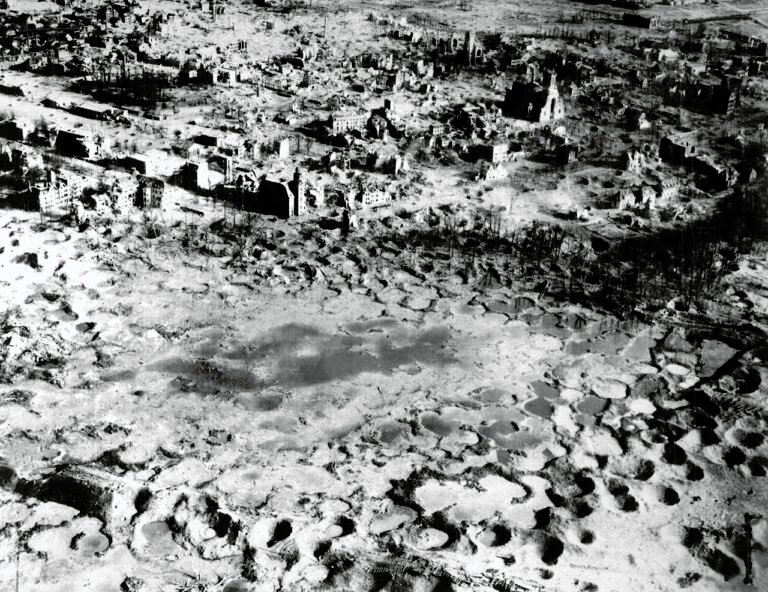
Were The Allied Bombings Of Germany War Crimes? – Mythbusting Berlin
The history of the Allied bombing of Germany during the Second World War still triggers fierce debate. Was reducing cities to rubble a necessary evil – justice from above in a just war – or an unforgivable crime? Can the intentional targeting of civilians ever be justified as militarily necessary?
In a conflict where all rules seemed to vanish, an even more pertinent question persists: by the very standards they would use to judge their

Were The Nazi Medical Experiments Useful? – Mythbusting Berlin
Before the Nazi period, German medicine was considered the envy of the world – a shining monument to progress. But deep within that monument, a rot was spreading, one which would collapse the entire structure into an abattoir. From the wreckage, we are left with a profoundly uncomfortable inheritance: a moral enigma wrapped in doctor’s whites.
What to make of the data, the images, and the terrible knowledge gleaned from unimaginable human suffering. Whether

What Are The Origins Of The Nazi Salute? – Mythbusting Berlin
A specter is haunting the modern mind, a gesture so charged with the dark electricity of history that its mere depiction can unleash a storm of controversy.
It is a simple movement: the right arm, stiff and straight, raised to the sky. But in that simplicity lies a terrifying power, a symbol of a regime that plunged the world into an abyss and a chilling reminder of humanity’s capacity for organised hatred.
This
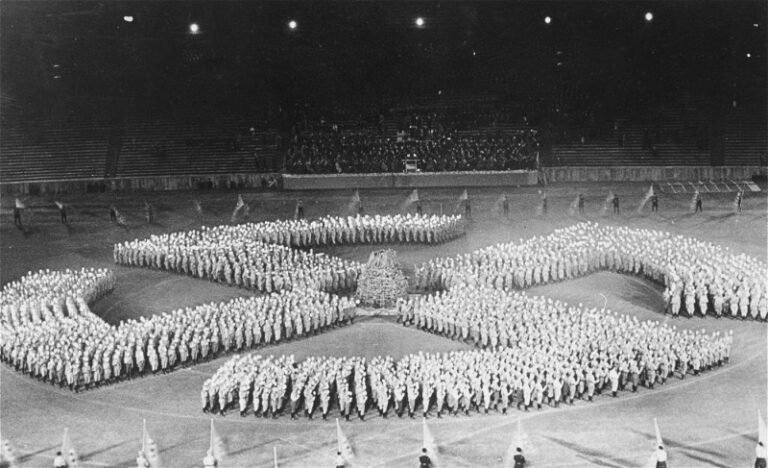
What Are The Origins Of The Nazi Swastika? – Mythbusting Berlin
Long before the legions of the Third Reich marched beneath its stark, unnerving geometry, the swastika lived a thousand different lives. It was a symbol of breathtaking antiquity, a globetrotting emblem of hope and good fortune that found a home in the most disparate of cultures. To even begin to understand its dark 20th-century incarnation, one must first journey back, not centuries, but millennia.
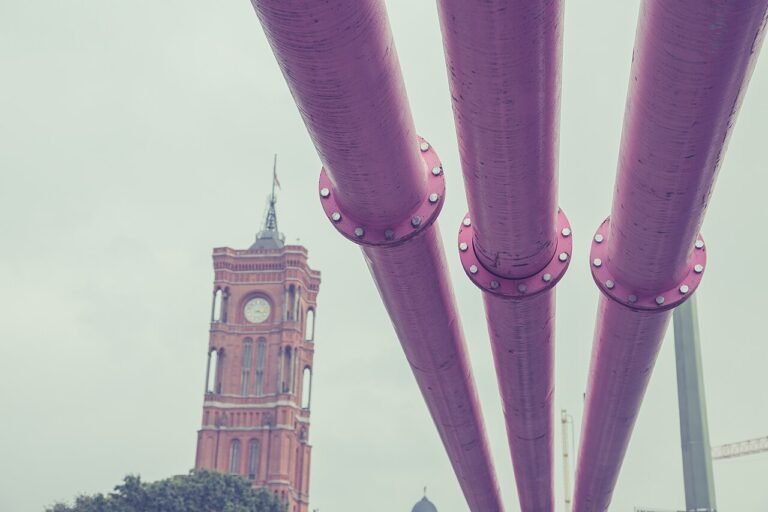
What Are The Pink Pipes In Berlin? – Mythbusting Berlin
A first-time visitor to Berlin could be forgiven for thinking the city is in the midst of a bizarre art installation. Bright pink pipes, thick as an elephant’s leg, climb out of the ground, snake over pavements, arch across roads, and disappear back into the earth. Are they part of a complex gas network? A postmodern artistic statement? A whimsical navigation system? These theories, all logical, are all wrong. The truth is far more elemental,
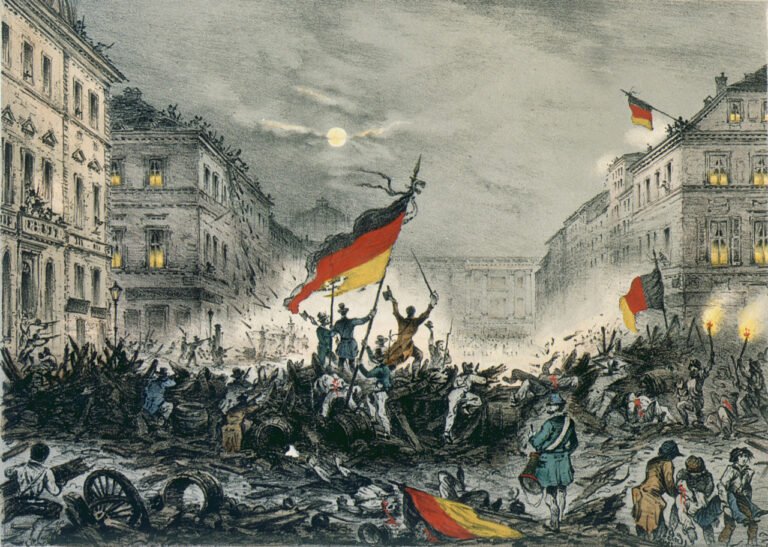
What Do The Colours Of The German Flag Symbolise? – Mythbusting Berlin
What does a flag mean? Is it merely a coloured cloth, or does it hold the hopes, struggles, and identity of a nation? The German flag, with its bold stripes of black, red, and gold, is instantly recognisable. But the story of its colours is a tumultuous journey through revolution, suppression, and reinvention. The common explanation for their symbolism is a simple, romantic verse, yet the truth is a far more complex and contested tale,

What Happened To Adolf Hitler’s Alligator? – Mythbusting Berlin
It is often said that you can tell a lot about a person by their relationship with animals; that owners often come to look and behave like their pets. Or is it perhaps more that people choose their pets to correspond to their personality? Nazi leader Adolf Hitler’s love of dogs, for example, is well documented but what is there to make of his relationship with reptiles?
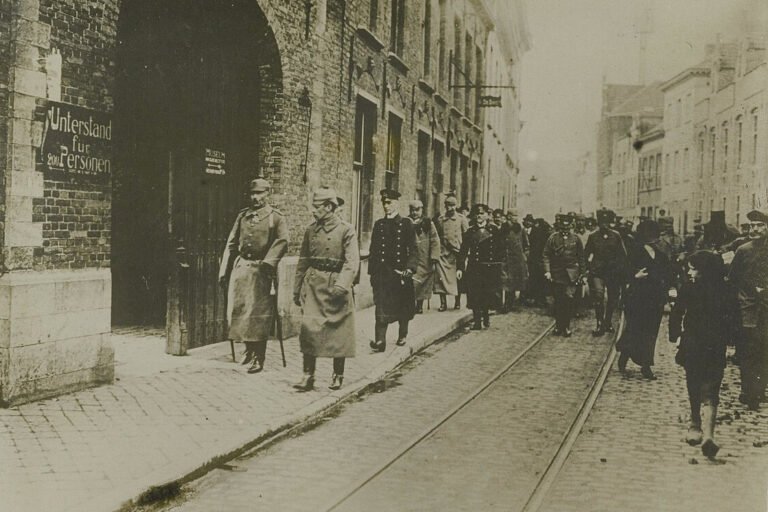
What Happenened To The German Royal Family? – Mythbusting Berlin
When the smoke cleared over the trenches in November 1918, the German Empire had evaporated, and with it, the divine right of the Hohenzollern dynasty. Conventional wisdom suggests the family simply vanished into the sepia-toned obscurity of history books—exiled, forgotten, and irrelevant. But dynasties, like weeds in a landscaped garden, are notoriously difficult to uproot entirely. The story of the German royals did not end with the Kaiser’s flight to Holland; it merely shifted gears.
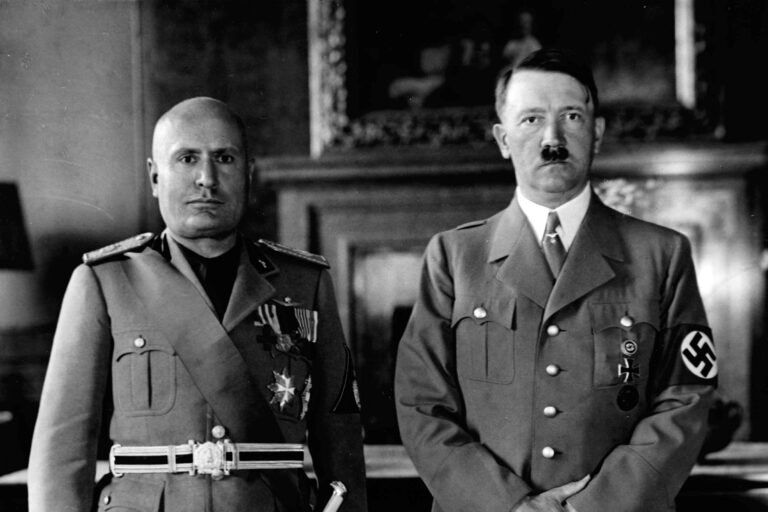
What Is The Difference Between Fascism & Nazism? – Mythbusting Berlin
While the terms ‘Fascist’ and ‘Nazi’ are often bandied around interchangeably as shorthand for tyranny – Italian fascism and German National Socialism were distinctly different beasts. Albeit ideological kin. One an ideology of state-worship, born from post-war chaos and national pride; the other built upon a fanatical, pseudo-scientific obsession with race. Two peas in the same totalitarian pod – twins in tyranny – more succinctly summarised as the Nazi chicken to the Fascist egg.

What Was Checkpoint Charlie? – Mythbusting Berlin
Checkpoint Charlie remains among Berlin’s most visited historical sites, famed worldwide for its significance during the Cold War. Originally established as a modest border-crossing point, it evolved dramatically over the decades into an international symbol of freedom, espionage, and intrigue. Today, critics and locals often dismiss it as little more than a tourist trap—Berlin’s Disneyland—but how exactly did Checkpoint Charlie get its peculiar name, and what truths hide behind its popularity?
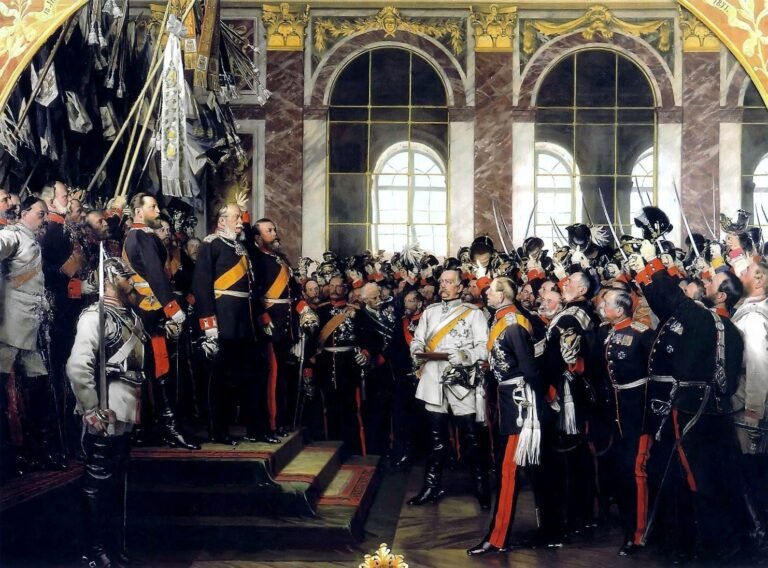
What Was Prussia? – Mythbusting Berlin
Prussia’s legacy is both remarkable and contentious—once a minor duchy, it rose dramatically to shape modern European history. Renowned for military discipline, administrative efficiency, and cultural sophistication, Prussia was instrumental in uniting the German states, laying foundations for a unified Germany. But how did this kingdom, with its roots in Baltic territories, achieve such prominence, and why does its complex history continue to evoke admiration, debate, and occasional discomfort in Germany today?
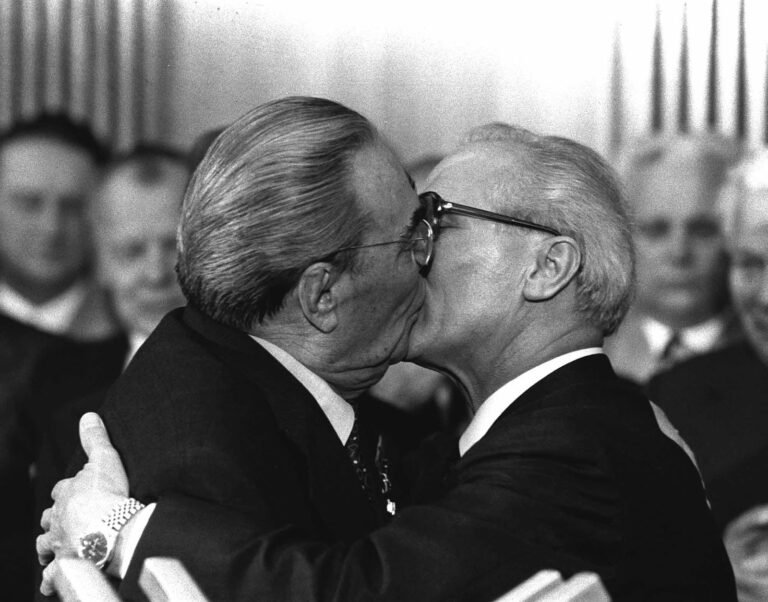
What Was The Socialist Kiss? – Mythbusting Berlin
It is one of the most curious and enduring images of the Cold War: two middle-aged, grey-suited men, locked in a fervent embrace, their lips pressed together in a kiss of apparent revolutionary passion. This was the ‘Socialist Fraternal Kiss’, a ritual that, for a time, seemed to encapsulate the unwavering solidarity of the Eastern Bloc.
But what was behind this seemingly intimate gesture? Was it a genuine expression of camaraderie, a piece of
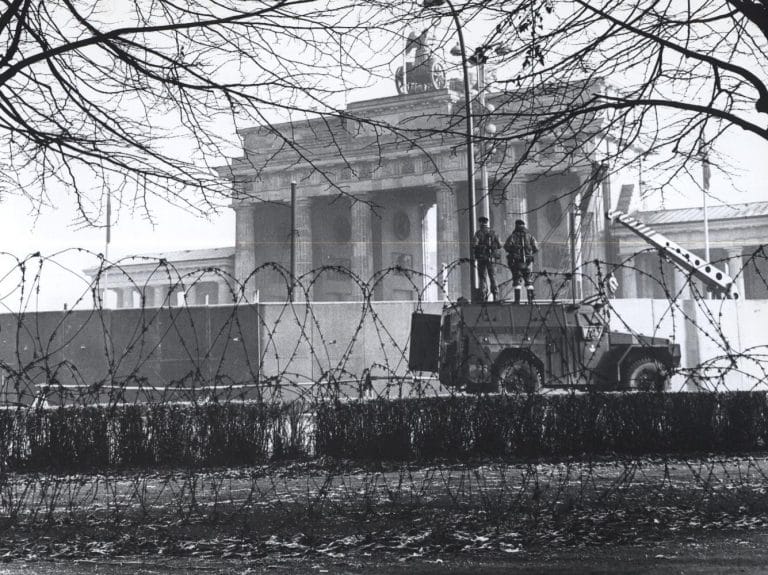
Who Built The Berlin Wall? – Mythbusting Berlin
One of the most common questions I have encountered from people curious about Berlin, and often so cryptically phrased. Who built the Berlin Wall? A simple five-word query, yet one that can be read one of two ways. More than thirty years since the ‘Fall of the Wall’, the story of its construction continues to baffle many who are mainly familiar with its existence through knowledge of its importance…
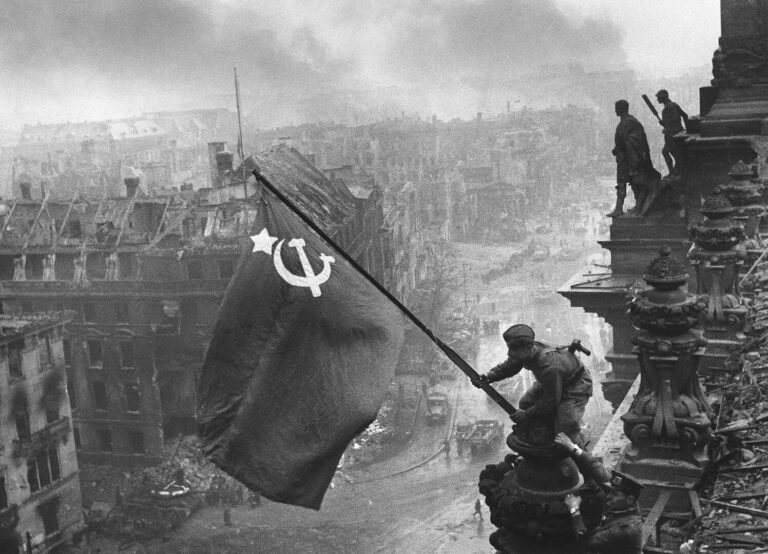
Who Really Raised The Soviet Flag On The Reichstag? – Mythbusting Berlin
One iconic photograph has come to symbolise the Red Army’s victory over Nazi Germany in 1945—the Soviet flag waving triumphantly above Berlin’s battered Reichstag building. Yet behind this enduring image lies controversy, confusion, and political manipulation. Who truly raised the Soviet banner atop the Reichstag? Was it a spontaneous act of heroism or carefully staged Soviet propaganda? Decades later, unraveling the truth reveals surprising layers beneath the mythologized symbol of Soviet triumph.
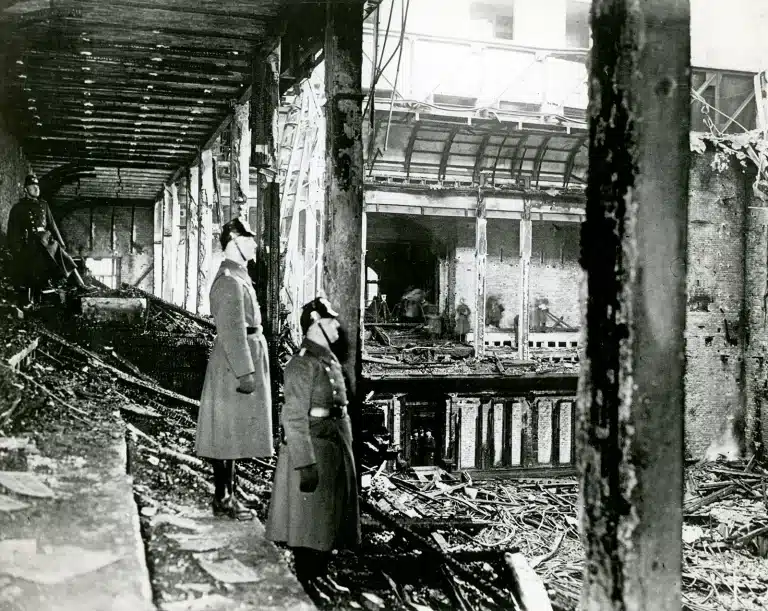
Who Was Really Responsible For The Reichstag Fire? – Mythbusting Berlin
Various theories have been posited as to who actually set fire to the German parliament in 1933. Was it the opening act in an attempted Communist coup or a calculated false flag operation carried out by elements of the Nazi Party, intended to create the conditions necessary for introducing single-party rule? And what part did the young man from Holland, arrested shirtless inside the building the night of the fire, play in this event?

Why Is Berlin The Capital Of Germany? – Mythbusting Berlin
There was little in its humble origins—as a twin trading outpost on a minor European river—to suggest that Berlin was destined for greatness. It sits on the flat expanse of the North European Plain, a landscape once dismissively referred to as the “sandbox of the Holy Roman Empire.” Unlike other world capitals, it lacks breathtaking scenery or a naturally defensible position. It is a city built not on majestic hills or a grand harbour, but



